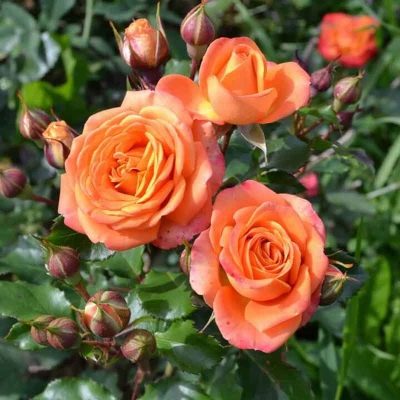
- Authors: Interplant B.V.
- Name synonyms: Babe, Orange baby
- Breeding year: 2006
- Group: spray
- The main color of the flower: orange
- Flower size: small
- Diameter, cm: 4-5
- Description of the bush: compact, upright
- Bush height, cm: 60-70
- Flowering period: from June to October
Modern breeders constantly surprise with new varieties with high decorative qualities. Spray roses occupy a special place in the flower market. This is a separate category, characterized by small buds and a wide variety of colors. One of these varieties is the Babe rose.
Description of the variety
This variety was bred in the Netherlands (year of selection - 2006). And also this species is known under the name Orange baby. It is ideal for planting along curbs, growing in containers or planting in groups.
The neat flowers are bright orange. They are small and do not exceed 4-5 centimeters in diameter. Colorful buds are collected in inflorescences. One shoot grows from 10 to 30 flowers. Thanks to the multi-flowered inflorescences, during the flowering period, the bushes are covered with a large number of small roses, the color of which contrasts favorably against the background of foliage. The aroma is weak.
Small bushes collected from upright shoots. Height - from 60 to 70 centimeters, width - 50-60 centimeters. The color of the leaves is rich green. The surface of the leaves is smooth and glossy.
The Babe variety is often used in floristry to compose bouquet and other compositions. Cut flowers are able to maintain their fresh appearance for 12 days.
Advantages and disadvantages
The advantages of this variety:
uncomplicated growing and care;
long flowering;
a small number of thorns, or their complete absence;
bright color of the petals;
the possibility of growing roses on terraces or balconies;
frost resistance.
Disadvantages:
weak aroma;
the small size of the buds, however, some consider such dimensions to be a feature, and not a disadvantage.
Flowering features
The long flowering period begins from the first days of summer and lasts until October (before the onset of cold weather). Another distinctive characteristic of the variety is re-flowering.
Landing
When choosing a place for growing spray roses, you need to take into account the peculiarity of each specific variety. Babe prefers well-lit areas, while it is desirable to protect the plants from strong and cold winds. Before planting, pits are made on the site with a size of 0.5x0.5 meters. A drainage layer is laid on the bottom (river sand or fine gravel is suitable). After that, a nutrient layer is made from organic dressings, fallen leaves or humus. The bush can now be placed in the hole.
The plant is covered with earth, which is carefully tamped around the stem. Young seedlings are watered with water at room temperature. About 10 liters are consumed per bush. The first watering should be abundant. This contributes to faster adaptation and rooting.
The selected area needs to be prepared. It is pre-cleaned of roots, weeds and other debris. The territory is dug up, destroying the rough crust on the surface. It is advisable to prepare planting holes several months before the expected planting date.
Growing and care
Babe prefers light, loose and fertile soil. For planting seedlings, choose one of two dates - from March to May or from August to October. Watering should be regular, as well as top dressing. Rose is highly resistant to atmospheric precipitation.Gardeners note high frost resistance - up to 29 degrees Celsius below zero.
In order for the decorative qualities of the variety to remain at their height, you need to regularly prune. With the arrival of spring, they get rid of sick, dry and deformed shoots. Faded branches are pruned. For the winter, the plants may not be covered, but in areas with long and frosty winters, it is advisable to additionally cover the planting.
Spray roses are considered unpretentious, so if the planting is done correctly, and the bush has time to take root, further flower care is minimized. It remains to periodically water, fertilize and weed the planting. If necessary, the bushes are sprayed with agents that protect against diseases and harmful insects.
Watering and feeding
Regular watering affects flowering. In a hot season, irrigation is performed more often so that the flower does not experience a lack of moisture. To keep moisture in the soil for as long as possible, cover the ground around the bushes with a thick layer of mulch. So that there are no burns on the foliage, watering is performed only after sunset. During the flowering period, the bushes are watered more often.
Reproduction
There are several ways to propagate a rose.
The easiest option is to divide the shrub into equal parts.
If you purchase seeds, you can grow the seedlings yourself.
Roses are often propagated by cuttings. From the stem, you need to cut off a part and lower it into a composition that stimulates growth.
You can get young seedlings by rooting cuttings. The branches of the main bush are buried. After a while, they will begin to take root and then become independent, fully formed plants.































































